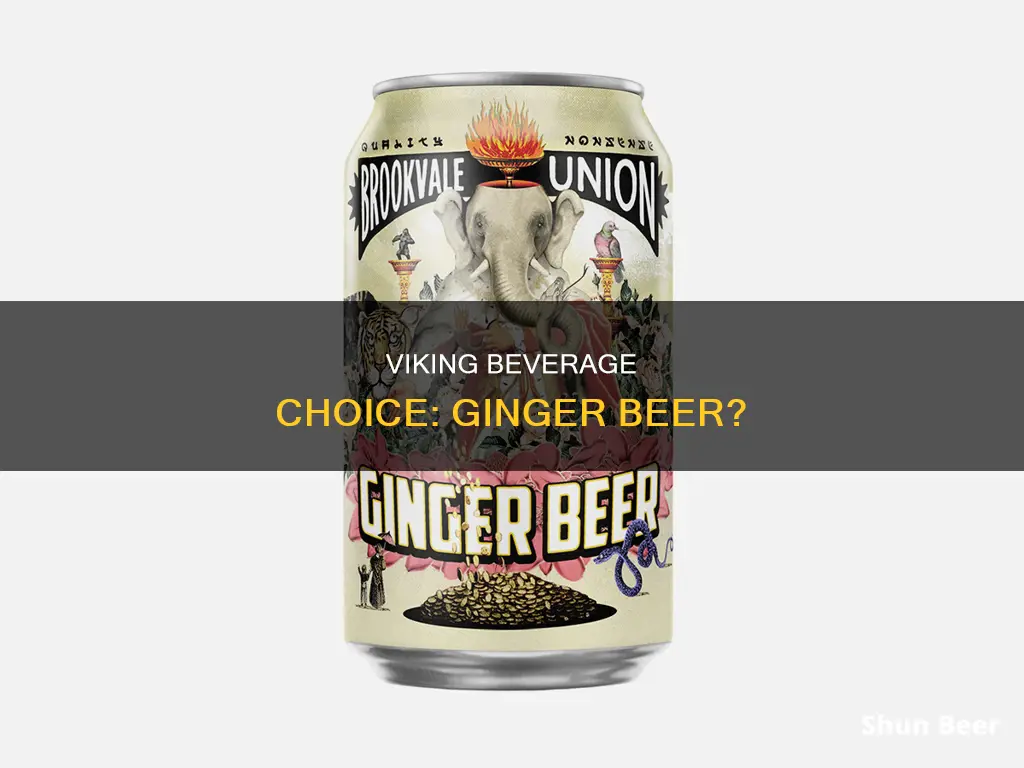
The Vikings are often depicted as drinking ale from the horns of their defeated enemies, but this is a romanticised image. In reality, Vikings drank water, ale, mead, and occasionally wine. There is some debate about whether they drank ginger beer, with no direct evidence in the form of historical records or archaeological findings. However, it is possible that they encountered ginger during their trade expeditions and incorporated it into their brewing traditions.
| Characteristics | Values |
|---|---|
| Drinking habits | Drinking habits are documented in history |
| Favorite drink | Mead, beer (ale) |
| Ginger beer | Identity is ambiguous |
| Drinking vessels | Drinking horns, wooden tankards, mead bowls |
| Written accounts | Mention of mead and ale in sagas and poetic tales |
| Drinking occasions | Everyday, weddings, feasts, celebrations, medicinal purposes |
| Trade routes | Silk Road, Volga trade route, maritime expeditions |
| Drinking customs | Communal drinking, sumbel |
What You'll Learn

Vikings drank mead, beer and ale
The Vikings are often depicted as bloodthirsty warriors drinking from the skulls of their defeated enemies. However, this is a romanticised image that doesn't reflect reality. In truth, Vikings drank fresh water, just like we do today.
However, they also enjoyed a variety of alcoholic beverages, including mead, beer and ale. Mead, a traditional honeyed nectar, was a staple at Viking feasts. It was made from fermented honey, water and often infused with various herbs. Mead was integral to Norse celebrations, fostering camaraderie among warriors.
Beer, or ale, was also commonly consumed by the Vikings. It was brewed from the fermentation of grain, typically barley, and sometimes flavoured with hops. Both weak and strong beer was produced, with the weak variety being suitable for children and adults to drink. Strong beer was reserved for special occasions, such as feasts and celebrations.
The Vikings also drank wine, but this was a luxury product imported from places like France, and only the wealthy could afford it.
The majority of brewing was done by women in Viking society, who were highly respected and in charge of everything inside the home. Beer and mead were also perfect for long sea journeys, as they had a longer shelf life than water and provided much-needed calories.
So, while Vikings may not have been drunken brutes, they certainly knew how to enjoy a variety of alcoholic beverages as part of their rich cultural traditions.
Beer After Two Days: Still Drinkable?
You may want to see also

Mead was made from honey
Mead, also known as "honey wine", is an alcoholic beverage made from honey, water, and yeast. It is believed to be the world's oldest alcoholic drink, dating back over 9,000 years. The process of making mead involves fermenting honey with water, and it is often infused with herbs, fruits, spices, grains, or hops to add unique flavours. The fermentation process, where yeast consumes the sugar from honey and converts it into alcohol, can take weeks to months depending on factors like temperature and ingredients used.
The Vikings held mead in high regard and considered it a sacred drink. It was an integral part of their culture and was consumed regularly during gatherings and celebrations, fostering camaraderie among warriors. Mead was also believed to be a "drink of the gods" or a "divine nectar" in Norse mythology. The Vikings likely had access to mead before beer, as evidenced by written records and archaeological findings.
The traditional recipe for mead consists of only three ingredients: honey, yeast, and water. However, modern variations may include additional ingredients such as fruits, spices, grains, or hops, resulting in creative flavour combinations. The type and quality of honey used significantly impact the taste and alcohol content of the final product.
The fermentation process is crucial in mead-making. It involves combining honey, water, and yeast, and allowing the mixture to ferment. During fermentation, yeast consumes the sugar from honey and converts it into alcohol. The length of this process depends on various factors, such as temperature and ingredients. Once fermentation is complete, some meads are aged in barrels, while others are bottled immediately.
Overall, mead-making is a simple process, but it requires patience during the lengthy fermentation stage to achieve the desired results. The versatility of mead, with its varying sweetness levels and ability to incorporate different ingredients, has contributed to its enduring popularity and resurgence in recent years.
Booze and Workouts: Beer vs. Bourbon's Impact
You may want to see also

Ale was flavoured with herbs and botanicals
Ale was a common drink in Viking culture, often shared among kin and comrades. It was brewed from barley, with hops sometimes added for flavour. However, before hops became the primary brewing flavour, wild herbs and spices were used to flavour ales. These hop-less drinks were known as "gruit".
Gruit ales usually contained three herbs: sweet gale (or bog myrtle), which gave the brew a resin-like taste and eucalyptus aroma; yarrow, which lent a bitter, astringent taste; and wild rosemary, which added a pleasantly fresh and spicy aroma, a bitter taste, and narcotic properties.
Other herbs and spices were also used in gruit ales and other traditional beers, including:
- Juniper
- Absinthe
- Green ginger
- Scots heather
- Licorice
- Common sage
The Vikings were known for their extensive trade routes, and their adventurous spirit may have led them to incorporate exotic spices into their brewing traditions.
Drinking Beer Post-Donation: What You Need to Know
You may want to see also

Alcohol was used for medicinal purposes
The Vikings' drinking vessels of choice were drinking horns made from cattle, and wooden cups. The main alcoholic beverages they consumed were mead, beer (ale), and fruit wine. Mead was made from honey, and beer was made from barley, with hops sometimes added for flavour. They also drank imported grape wine, though this was a luxury only the wealthy could afford.
Alcohol has been used for medicinal purposes since ancient times. It was used as a general anaesthetic before safer options became available, and was also used to sterilise wounds. In places with poor public sanitation, such as medieval Europe, drinking alcohol was a way to avoid water-borne diseases like cholera.
By the early 19th century, alcohol was in widespread use in medical treatments in England. Physicians prescribed it for ailments ranging from snakebites to disease control. It was also used as a painkiller during surgery, and to sedate women during labour.
However, the rise of scientific medicine after 1850 led to changing views on alcohol's therapeutic value. By the end of the century, its value as a medicine was widely disputed and discredited among advanced practitioners. In 1916, whiskey and brandy were removed from the list of scientifically approved medicines in the US Pharmacopeia. The following year, the American Medical Association voted to support prohibition.
During the Prohibition years, alcohol could still be obtained legally through a physician's prescription, with the government allowing the limited production and distribution of whiskey for this purpose.
Fear of Drinking Corona Beer?
You may want to see also

Drinking customs were an important part of Viking culture
The Vikings' love for alcohol extended beyond mead and ale. Fruit wines, made from various fruits, were another popular drink, although they were consumed less frequently due to their expensive nature. The Vikings also drank imported beverages, such as wine from the Frankish and Byzantine empires, which were often reserved for the elite. Additionally, they may have had access to distilled spirits, with archaeological evidence suggesting they practised rudimentary forms of distillation, producing a spirit called "aquavit" or "burnt wine".
The Vikings' drinking customs were deeply intertwined with their cultural and social rituals. Communal drinking was an essential part of their culture, and it often took place in longhouses or "mead halls". Drinking horns, made from cattle, played a significant role in these gatherings, as they encouraged quick drinking or sharing among the group. The act of sharing an ale horn could seal deals or indicate a strong accord between individuals. Drinking events, such as the "sumbel" or "symbel", were communal drinking rituals held in the mead hall of a liege lord. These events strengthened social bonds, reinforced hierarchies, and provided opportunities for social advancement.
The Vikings' drinking culture was also influenced by their trading activities. Their extensive trade networks allowed them to import alcoholic beverages from other regions, such as wine from the Mediterranean world. Additionally, their contact with diverse cultures through trade exposed them to new ingredients and brewing techniques, potentially including ginger beer. While there is no direct evidence of Vikings consuming ginger beer, historical records and trade routes suggest the possibility of its inclusion in their drinking repertoire.
Drinking Beer at Solomon's Island: Is it Allowed?
You may want to see also
Frequently asked questions
It is unclear whether Vikings drank ginger beer. While there is no direct historical or archaeological evidence to support this claim, it is possible that they incorporated ginger into their brewing traditions as they were known for their adventurous spirit and extensive trade routes.
The Vikings' main alcoholic beverages were mead and beer (ale). They also drank fruit wine, although very infrequently due to its expense.
Mead is a traditional Viking beverage made from honey and water, often infused with herbs. It was considered sacred and played an integral role in Norse celebrations.
Ale is a type of beer that was commonly consumed in Viking culture. It was brewed from barley, with hops sometimes added for flavour.







